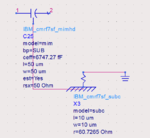ktx2222
Member level 5
Hi everyone,
I have one question about the dependence of parasitic of MIM cap on substrate contact resistance. I am using IBM pdk. I found that the parasitic of MIM cap in this process strongly depends on substrate contact. Please take a look at attached image:

The parasitic of cap is very small if the subc is set to 10 kOhm (default resistance of subc). However, if subc is set to 60 Ohm by increasing the area of subc (as indicated in photo), the parasitic of MIM cap becomes significant. I don't know the effect of subc in a full circuit. How many subcs/How much area of subc should I put in the real layout? Am I right if I put only one subc in a layout to have small parasitic of MIM cap?
Please help me.
Thank in advanced.
I have one question about the dependence of parasitic of MIM cap on substrate contact resistance. I am using IBM pdk. I found that the parasitic of MIM cap in this process strongly depends on substrate contact. Please take a look at attached image:

The parasitic of cap is very small if the subc is set to 10 kOhm (default resistance of subc). However, if subc is set to 60 Ohm by increasing the area of subc (as indicated in photo), the parasitic of MIM cap becomes significant. I don't know the effect of subc in a full circuit. How many subcs/How much area of subc should I put in the real layout? Am I right if I put only one subc in a layout to have small parasitic of MIM cap?
Please help me.
Thank in advanced.